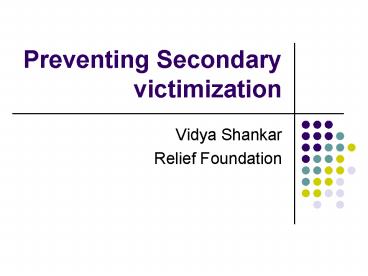Preventing Secondary victimization - PowerPoint PPT Presentation
1 / 5
Title:
Preventing Secondary victimization
Description:
Victimization which occurs, not as a direct result of the ... leading to hoarding or stealing in the dorm. Lesbianism. Bouncing back and forth into the system ... – PowerPoint PPT presentation
Number of Views:111
Avg rating:3.0/5.0
Title: Preventing Secondary victimization
1
Preventing Secondary victimization
- Vidya Shankar
- Relief Foundation
2
What is Secondary Victimization
- Victimization which occurs, not as a direct
result of the criminal act, but through the
response of institutions and individuals to the
victim. - Social injury
- caused by society in the aftermath of the crime.
- treated insensitively or not receiving the
services and/or information that a victim
requires.
3
What constitutes S.V
- refusal to recognize the victims experience as
criminal victimization - intrusive or inappropriate conduct, abuse in
institutions - Whole process of criminal investigation and trial
- victim perceives difficulties in balancing
their rights with those of accused or offender - criminal justice procedures that do not take the
perspective of victim into account - hurried schedules, cumbersome procedures that may
affect a victims sense of dignity and control - Delayed process, repeat recounting of crime
4
In the Institutions..
- Language barrier
- Disability, ADHD, Learning difficulties
- Extreme poverty and abuse insecurity
- leading to hoarding or stealing in the dorm
- Lesbianism
- Bouncing back and forth into the system
- Abuse in the dorm by older / powerful peers
- Blaming the child victim
5
In the context of Children in need of care and
protection
- Runaway, missing, abandoned, abducted,
- sick, abused and exploited children
- How to prevent secondary victimisation
- Immediate needs of the child
- Questioning the child appropriately
- Positive interactions building trust
- Keeping promises and aftermath
- Follow up till speedy justice and rehabilitation































